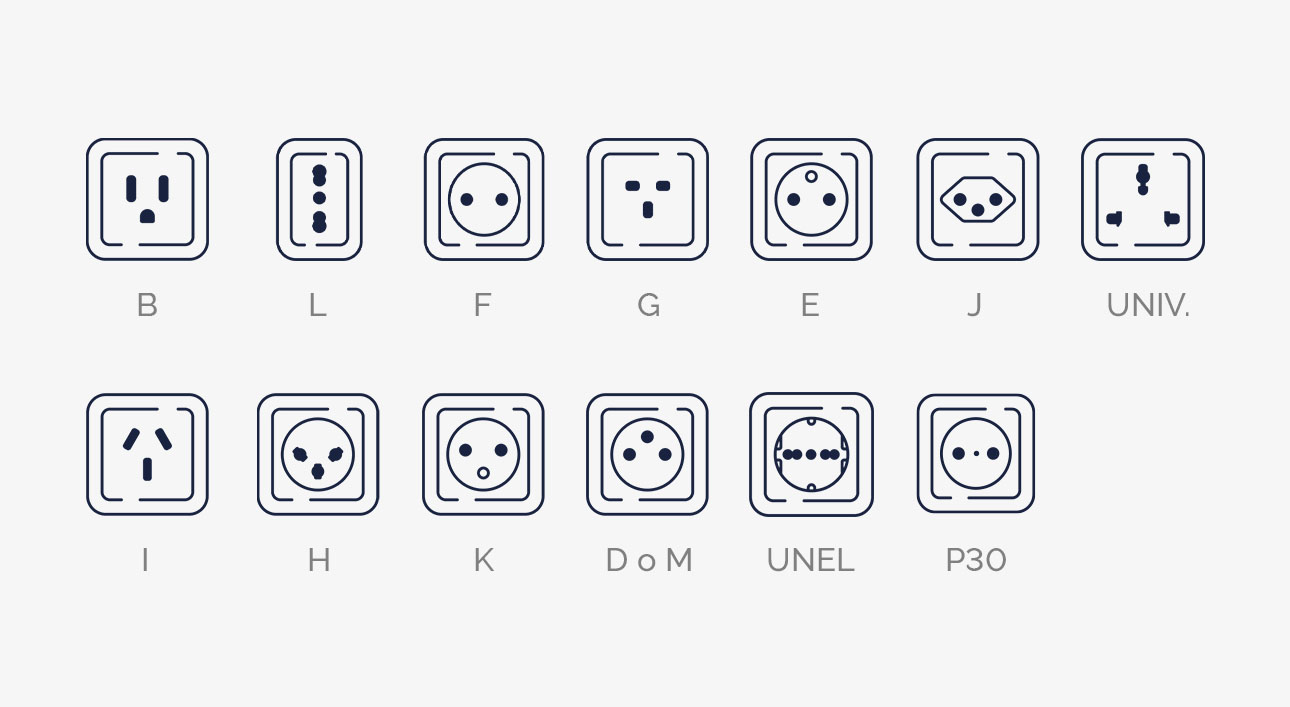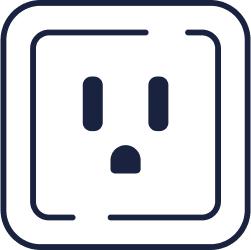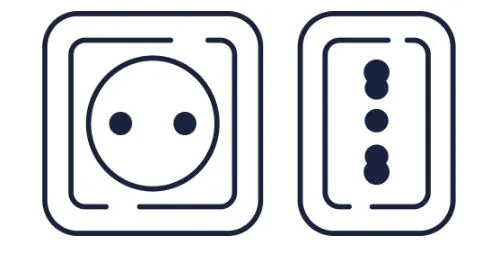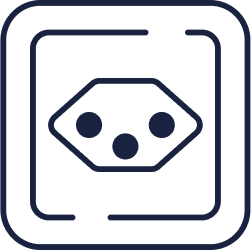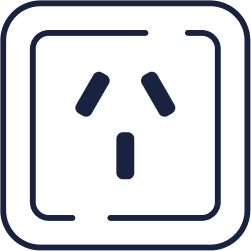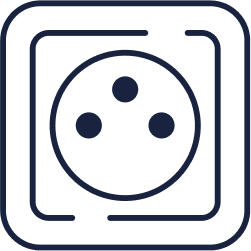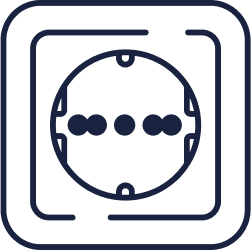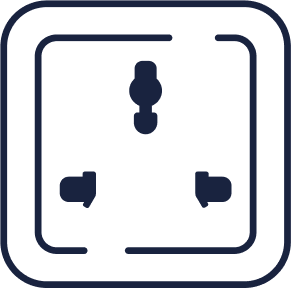Request information
For large buyers or companies it is possible to have price lists with different prices and payment terms.
Today’s market offers a wide range of power outlets designed to meet different usage needs and comply with the standards of each country.
Power outlets are essential for connecting devices and appliances safely and efficiently. In Italy, their technical specifications and standards are defined by the CEI 23-50 regulation.
Keep reading to discover the main types of power outlets used in Italy and abroad, their features, how to identify them, and many other useful details!
A power outlet provides the connection between the user’s devices and the electrical system, playing a key role in ensuring the safe and efficient operation of appliances and equipment in any environment.
It represents the final component of the electrical system, enabling access to the energy supplied through a specific cable network.
Recognizing the type of outlet is the first essential step in guaranteeing a safe and fully functional installation for users.
It is therefore essential not only to identify the shape of the plug holes, but also to understand the technical specifications related to load capacity, compatibility, and, of course, safety.
Identification becomes even more important in modern installations that demand ergonomics and high performance, such as ASA’s design-driven and highly functional solutions.
The identification of a power outlet is determined by a set of internationally standardized technical parameters, specifically:
Different markings certify compliance with regulations and quality standards, an aspect to which ASA pays particular attention, with the sole goal of offering high-performance solutions.
The main markings include:
Each country has its own standards, which determine variations in current load (expressed in amperes and corresponding wattage), shape, number of contacts, and size.
Keep reading our guide to explore the different types of power outlets used around the world.
In North and Central America, as well as in Japan, two types of 120-volt power outlets are commonly used:
They are similar to the outlets used in the UK but have thinner blades and can be used with universal adapters.
In Italy, the most common power outlet is the Type C, connected with 1.5 mm section cables and featuring two or three symmetrical holes with a 4 mm diameter. It can supply up to 10 A with a maximum power of 2000 W. It is not recommended to connect high-consumption appliances using a Schuko adapter or triple plug, as this may cause overheating.
The second Italian model, the Type L, is considered more efficient than Type C because it supports a higher current load and ensures improved electrical contact.
Rated for 16 A and up to 3.5 kW, it features larger holes and 2.5 mm conductor compatibility, making it safer and more reliable for high-power appliances such as ovens and dishwashers.
Formally known as the hybrid F/L 16 A outlet, the P30 Standard is currently the most modern, versatile, and widely used solution in Italy.
It represents the ideal balance between the national Type L and the European Type F (Schuko) standards. Defined by the CEI 23-50 regulation (ref.P30), it is designed to ensure maximum flexibility and safety within a single connection point.
Its main advantage is compatibility with multiple plug types: Schuko (Type F), Italian 16 A (P11 – Type L), and Italian 10 A (P10 – Type L).
This versatility eliminates the need for adapters and ensures safe, efficient operation with both Italian and European 16 A devices.
The Schuko, or Type F outlet, is easily recognized by its two horizontally aligned holes and can supply up to 16 amperes. In this design, the grounding system is replaced by two lateral contacts. It is ideal for powering large appliances, computers, monitors, and other high-consumption devices.
Common in Germany, Austria, the Netherlands, Spain, Sweden, Norway, Finland, Portugal, and Eastern Europe, it has become, together with Type E, the standard across Europe.
First of all, it’s worth noting that the Schuko outlet, also known as CEE 7/4, is now used in most European countries. Its live parts are well protected, making it suitable not only for household appliances but also for garden tools and electric vehicle charging.
This outlet type is specifically designed to ensure maximum safety as its structure prevents accidental contact between the hand and the plug pins.
It has gradually become the European standard outlet and it is used by most small and large appliances on the market today.
The CEI 64-8 standard defines its proper application in kitchen installations and for connecting washing machines, eliminating the need for adapters.
Refrigerators, washing machines, ovens, dryers, and dishwashers (all high-consumption devices) are typically powered by this Franco-German outlet, compatible across all European Union countries.
RELATED READING
USB Type-C socket: The future of data and power transmission
Used in the United Kingdom, Commonwealth countries, and former British colonies such as Hong Kong and India, the British outlet provides 240 V and features three rectangular holes arranged in a triangular pattern, two horizontal and one vertical for grounding.
Each plug includes an internal fuse rated at 3, 5, or 13 amperes, which serves as protection for the connected device.
Similar to the Schuko, the Type E outlet is the second most widely used in Europe. It also features two holes but differs in one key aspect: a male grounding pin protruding from the socket itself.
Type E outlets are commonly found in France, Belgium, Luxembourg, the Czech Republic, Poland, and several other European countries.
The Swiss outlet shares many features with the Italian Type L outlet. It has three holes arranged in a triangular pattern and is also compatible with Italian Type C two-pin plugs.
The Chinese and Australian outlet, also used in Argentina, features rectangular holes with the two live pins arranged in a V shape. It provides between 10 and 20 amperes of current.
Type H outlets are characterized by wide central holes that can accommodate the round-pin version of the Type C plug. However, the original Type H plug can be hazardous, as it lacks insulation to protect against electric shock.
It is currently being phased out and replaced with a safer round-pin version.

In Denmark, along with Types C, E, and F, the Type K outlet is also used. Similar to the German Type F, it has three pins, but the third pin serves as the grounding contact instead of the two side clips found in the Schuko design.
Danish regulations now permit the use of Schuko outlets, and Type K is therefore being gradually phased out.
The Type D plug features three large round pins arranged in a triangular pattern and is rated for 5 amperes.
Type M plugs are used alongside Type D for higher-power appliances, which is why some sockets are compatible with both Type D and Type M plugs.
The UNEL European outlet features two cylindrical contacts (4.8 mm in diameter) for phase and neutral and is compatible with both German and Italian three-pin plugs, including grounding.
It is used to connect loads of up to 16 A in 220 V AC circuits. The UNEL plug and socket combination is considered a very safe and reliable solution.
Used in the same countries as Type A and Type C (also known as the Europlug), this is the two-pin Italian plug without a grounding contact. It is widely used across Europe and is among the most common plug types worldwide.
The two-pin Italian plug without grounding contact is undoubtedly the most widely used type internationally.
Common in countries that also use Type A and Type C (Europlug) outlets, it offers excellent compatibility, a feature that makes it not only practical and easily recognizable but also a true symbol of global standardization shared by many nations.
For large buyers or companies it is possible to have price lists with different prices and payment terms.
